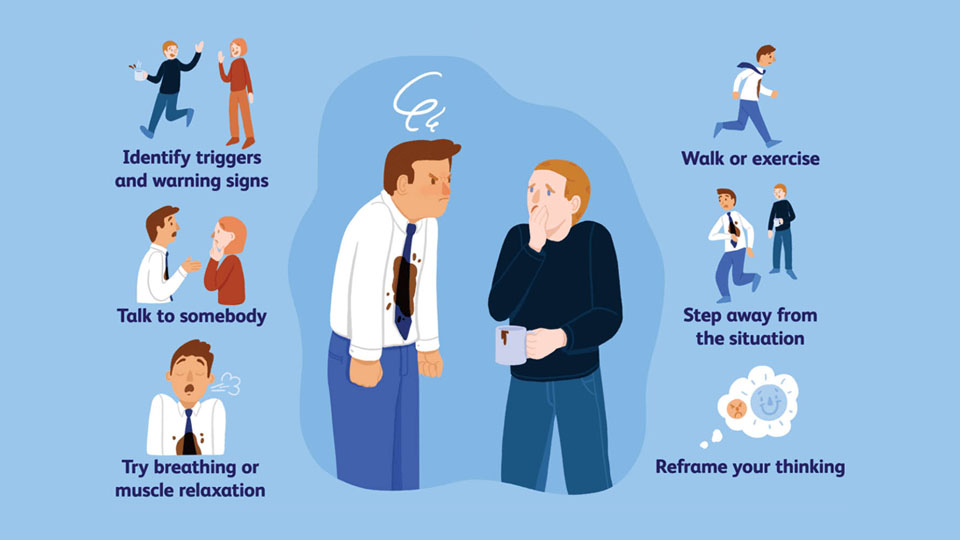
Anger, unlike the other five emotions (Love, Sadness, Happiness, Fear and Shame/Guilt), can cause immense physical and mental anguish to self and those around us. One is allowed to experience (Anger Experience) and express (Anger Expression) Anger but there is also this expectation of us to keep it in check (Anger Management) or reign it in. Because unhealthy Anger (Rage) has consequences that can result in breaking relationships/friendships, losing goodwill, damaging career/job prospects and even have us come face to face with the Law.
Every time we experience anger, it impacts us on 3 levels, namely physiological (physical changes like trembling, raised heart rate, clenched jaw or fists and tensed muscles in the neck and shoulder), cognitive (our thoughts and beliefs about the triggering person/event or situation) and behavioural (the way we display the emotion of anger on self or others). While some of us implode, others explode. So very clearly we each have our own bandwidth to tolerate annoyance and irritation and distinct ways of communicating the same. Open to us are aggressive, passive-aggressive or passive styles to communicate anger.
Obviously at this point you are wondering what healthy anger is. Healthy anger is annoyance and irritation that leads us towards resolution rather than aggression. It can be intense but not overwhelming and does not lead to loss of control and intimidation and vindictiveness. Which implies, the individual has tolerant, flexible and accepting attitudes towards the triad that includes self, the other person and the world at large or life in general.
Those with healthy anger also are more resilient and bounce back easily to normalcy. While those with unhealthy anger have a short fuse, low threshold to tolerate frustration and poor impulse control.
There is even a school of thought that believes anger is fabricated. Choices we make with regard to whom we display our anger on and how and why we convey the intensity of the anger we experience. For example: you are having an intense argument with a family member at home. Yelling voices, profanity, thumping fists et al and your boss calls. You take the call and sound as normal and formal as you can. None of the anger experienced 2 minutes ago by you is expressed or displayed at the boss. But the moment you end the call, back you go to being that enraged person picking up from where you left off with no effort. Sounds familiar?
Rage rooms are much in fashion now. Allowing for us to vent our anger in carefully curated rooms without legal consequences. Think pressure cooker. We have all been told that letting off steam is cathartic and allows for us to come back to normalcy. Punch that pillow, go for a run are some of the suggestions thrown at us to exorcise anger (with physical exertion).
But new studies tell us quite the opposite. Venting anger might not be such a good idea after all. In fact it could be counter productive. Because venting further raises our already elevated arousal levels. So it would be best to engage in activities that instead help in decreasing our high levels of arousal.
Some calming activities that help with Anger Management would be slow-flow yoga, mindfulness exercises, Progressive Muscle Relaxation techniques (PMR), diaphragmatic breathing etc.
I also encourage my clients to consciously engage their five senses: Sense of sight – as in a calm blue sky/sea, auditory sense – as in sounds of birds chirping or the wind blowing, olfactory sense – as in perfumed candles or incense sticks, sense of touch – as in stroking our pet or simply running a feather on the soles of our feet and sense of taste – as in allowing for a piece of chocolate to quietly dissolve on our tongue and allow for the texture, temperature and taste to melt our rage. This way we don’t allow thoughts and emotions to overwhelm us instead.
Anger Management also involves us processing the trigger, our beliefs about it and the emotions and behaviours it gives rise to, in us. But all of which after we first calm ourselves down. This way we choose a response rather than have a reaction. Helping us perhaps towards a resolution.
e-mail: [email protected]








Recent Comments